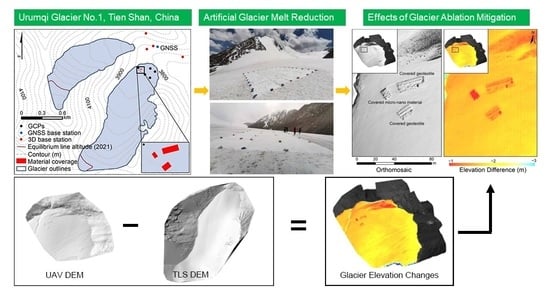Quantifying the Artificial Reduction of Glacial Ice Melt in a Mountain Glacier (Urumqi Glacier No. 1, Tien Shan, China)
Abstract
:1. Introduction
2. Study Site
3. Data and Methodology
3.1. Artificial Glacier Melt Reduction Experiment
3.2. Glaciological Mass Balance
3.3. Geodetic Mass Balance
3.3.1. TLS Digital Elevation Model (DEM)
3.3.2. UAV DEM
3.3.3. Co-Registration of DEMs and Mass Balance Calculation
3.3.4. Uncertainty Assessment
3.4. Ice and Snow Spectral Reflectance Measurements
3.5. Meteorological Measurements
4. Results
4.1. Effects of Glacier Ablation Mitigation
4.2. Difference between the Three Covering Materials for Reducing Ablation
5. Discussion
5.1. Quality of Point Cloud Data and DEM Differencing
5.2. Accuracy of Geodetic Surface Change
5.3. Possible Reasons for Reducing Ablation Differences
5.4. Compared with Previous Similar Studies
5.5. Feasibility Analysis of the Artificial Reduction of Glacier Melt
6. Conclusions
Author Contributions
Funding
Data Availability Statement
Conflicts of Interest
References
- Fischer, A.; Helfricht, K.; Stocker-Waldhuber, M. Local reduction of decadal glacier thickness loss through mass balance management in ski resorts. Cryosphere 2016, 10, 2941–2952. [Google Scholar] [CrossRef]
- Gruenewald, T.; Wolfsperger, F.; Lehning, M. Snow farming: Conserving snow over the summer season. Cryosphere 2018, 12, 385–400. [Google Scholar] [CrossRef]
- Spandre, P.; Morin, S.; Lafaysse, M.; Lejeune, Y.; Francois, H.; George-Marcelpoil, E. Integration of snow management processes into a detailed snowpack model. Cold Reg. Sci. Technol. 2016, 125, 48–64. [Google Scholar] [CrossRef]
- Nestler, A.; Huss, M.; Ambartzumian, R.; Hambarian, A.J.G. Hydrological Implications of Covering Wind-Blown Snow Accumulations with Geotextiles on Mount Aragats, Armenia. Geosciences 2014, 4, 73–92. [Google Scholar] [CrossRef]
- Olefs, M.; Obleitner, F. Numerical simulations on artificial reduction of snow and ice ablation. Water Resour. Res. 2007, 43, 71–81. [Google Scholar] [CrossRef]
- Olefs, M.; Lehning, M. Textile protection of snow and ice: Measured and simulated effects on the energy and mass balance. Cold Reg. Sci. Technol. 2010, 62, 126–141. [Google Scholar] [CrossRef]
- Immerzeel, W.W.; Lutz, A.F.; Andrade, M.; Bahl, A.; Baillie, J.J.N. Importance and vulnerability of the world’s water towers. Nature 2020, 577, 364–369. [Google Scholar] [CrossRef]
- Farinotti, D.; Longuevergne, L.; Moholdt, G.; Duethmann, D.; MoLg, T.; Bolch, T.; Vorogushyn, S. Substantial glacier mass loss in the Tien Shan over the past 50 years. Geoscience 2015, 8, 716–722. [Google Scholar] [CrossRef]
- Olefs, M.; Fischer, A. Comparative study of technical measures to reduce snow and ice ablation in Alpine glacier ski resorts. Cold Reg. Sci. Technol. 2008, 52, 371–384. [Google Scholar] [CrossRef]
- Senese, A.; Azzoni, R.S.; Maragno, D.; D’Agata, C.; Fugazza, D.; Mosconi, B.; Trenti, A.; Meraldi, E.; Smiraglia, C.; Diolaiuti, G. The non-woven geotextiles as strategies for mitigating the impacts of climate change on glaciers. Cold Reg. Sci. Technol. 2020, 173, 103007. [Google Scholar] [CrossRef]
- Huss, M.; Schwyn, U.; Bauder, A.; Farinotti, D. Quantifying the overall effect of artificial glacier melt reduction in Switzerland, 2005–2019. Cold Reg. Sci. Technol. 2021, 184, 103237. [Google Scholar] [CrossRef]
- Wang, F.; Yue, X.; Wang, L.; Li, H.; Du, Z.; Ming, J.; Li, Z. Applying artificial snowfall to reduce the melting of the Muz Taw Glacier, Sawir Mountains. Cryosphere 2020, 14, 2597–2606. [Google Scholar] [CrossRef]
- Li, Z.; Li, H.; Chen, Y. Mechanisms and Simulation of Accelerated Shrinkage of Continental Glaciers: A Case Study of Urumqi Glacier No. 1 in Eastern Tianshan, Central Asia. J. Earth. Sci. 2011, 22, 423–430. [Google Scholar] [CrossRef]
- Zemp, M.; Thibert, E.; Huss, M.; Stumm, D.; Denby, C.R.; Nuth, C.; Nussbaumer, S.U.; Moholdt, G.; Mercer, A.; Mayer, C.; et al. Reanalysing glacier mass balance measurement series. Cryosphere 2013, 7, 1227–1245. [Google Scholar] [CrossRef]
- World Glacier Monitoring Service (WGMS). Fluctuations of Glaciers Database; World Glacier Monitoring Service: Zurich, Switzerland, 2013. [Google Scholar] [CrossRef]
- Han, T.; Ding, Y.; Ye, B.; Liu, S.; Jiao, K. Mass-balance characteristics of Urumqi glacier no. 1, Tien Shan, China. Ann. Glaciol. 2006, 43, 323–328. [Google Scholar] [CrossRef]
- Yue, X.; Zhao, J.; Li, Z.; Zhang, M.; Fan, J.; Wang, L.; Wang, P. Spatial and temporal variations of the surface albedo and other factors influencing Urumqi Glacier No. 1 in Tien Shan, China. J. Glaciol. 2017, 63, 899–911. [Google Scholar] [CrossRef]
- Moelg, T.; Maussion, F.; Scherer, D. Mid-latitude westerlies as a driver of glacier variability in monsoonal High Asia. Nat. Clim. Change 2014, 4, 68–73. [Google Scholar] [CrossRef]
- Wang, P.; Li, Z.; Li, H.; Wang, W.; Zhou, P.; Wang, L. Characteristics of a partially debris-covered glacier and its response to atmospheric warming in Mt. Tomor, Tien Shan, China. Glob. Planet. Chang. 2017, 159, 11–24. [Google Scholar] [CrossRef]
- Zemp, M.; Jansson, P.; Holmlund, P.; Gartner-Roer, I.; Koblet, T.; Thee, P.; Haeberli, W. Reanalysis of multi-temporal aerial images of Storglaciaren, Sweden (1959–99)—Part 2: Comparison of glaciological and volumetric mass balances. Cryosphere 2010, 4, 345–357. [Google Scholar] [CrossRef]
- Mukupa, W.; Roberts, G.W.; Hancock, C.M.; Al-Manasir, K. A review of the use of terrestrial laser scanning application for change detection and deformation monitoring of structures. Surv. Rev. 2017, 49, 99–116. [Google Scholar] [CrossRef]
- Besl, P.J.; McKay, N.D. A method for registration of 3-d shapes. In Sensor Fusion IV: Control Paradigms and Data Structures; SPIE: Philadelphia, PA, USA, 1992; Volume 1611, pp. 586–606. [Google Scholar] [CrossRef]
- Zhang, Z.Y. Iterative point matching for registration of free-form curves and surfaces. Int. J. Comput. Vis. 1994, 13, 119–152. [Google Scholar] [CrossRef]
- Perroy, R.L.; Bookhagen, B.; Asner, G.P.; Chadwick, O.A. Comparison of gully erosion estimates using airborne and ground-based LiDAR on Santa Cruz Island, California. Geomo 2010, 118, 288–300. [Google Scholar] [CrossRef]
- RIEGL Laser Measurement Systems. 3D Terrestrial Laser Scanner Riegl VZ®-4000/Riegl VZ®-6000 General Description and Data Interfaces; RIEGL Laser Measurement Systems: Horn, Austria, 2014; pp. 1–466. [Google Scholar]
- Xu, C.; Li, Z.; Wang, F.; Li, H.; Wang, W.; Wang, L. Using an ultra-long-range terrestrial laser scanner to monitor the net mass balance of Urumqi Glacier No. 1, eastern Tien Shan, China, at the monthly scale. J. Glaciol. 2017, 63, 792–802. [Google Scholar] [CrossRef]
- Turner, D.; Lucieer, A.; Watson, C. An Automated Technique for Generating Georectified Mosaics from Ultra-High Resolution Unmanned Aerial Vehicle (UAV) Imagery, Based on Structure from Motion (SfM) Point Clouds. Remote. Sens. 2012, 4, 1392–1410. [Google Scholar] [CrossRef]
- Furukawa, Y.; Ponce, J. Accurate, Dense, and Robust Multiview Stereopsis. IEEE Trans. Pattern Anal. Mach. Intell. 2010, 32, 1362–1376. [Google Scholar] [CrossRef] [PubMed]
- Nuth, C.; Kaab, A. Co-registration and bias corrections of satellite elevation data sets for quantifying glacier thickness change. Cryosphere 2011, 5, 271–290. [Google Scholar] [CrossRef]
- Rolstad, C.; Haug, T.; Denby, B. Spatially integrated geodetic glacier mass balance and its uncertainty based on geostatistical analysis: Application to the western Svartisen ice cap, Norway. J. Glaciol. 2009, 55, 666–680. [Google Scholar] [CrossRef]
- Huss, M.; Bauder, A.; Funk, M. Homogenization of long-term mass-balance time series. Ann. Glaciol. 2009, 50, 198–206. [Google Scholar] [CrossRef]
- Klug, C.; Bollmann, E.; Galos, S.P.; Nicholson, L.; Prinz, R.; Rieg, L.; Sailer, R.; Stoetter, J.; Kaser, G. Geodetic reanalysis of annual glaciological mass balances (2001–2011) of Hintereisferner, Austria. Cryosphere 2018, 12, 833–849. [Google Scholar] [CrossRef]
- Ming, J.; Xiao, C.; Wang, F.; Li, Z.; Li, Y. Grey Tienshan Urumqi Glacier No.1 and light-absorbing impurities. Environ. Sci. Pollut. Res. 2016, 23, 9549–9558. [Google Scholar] [CrossRef]
- Kraaijenbrink, P.; Meijer, S.W.; Shea, J.M.; Pellicciotti, F.; De Jong, S.M.; Immerzeel, W.W. Seasonal surface velocities of a Himalayan glacier derived by automated correlation of unmanned aerial vehicle imagery. Ann. Glaciol. 2016, 57, 103–113. [Google Scholar] [CrossRef]
- Wigmore, O.; Mark, B. Monitoring tropical debris-covered glacier dynamics from high-resolution unmanned aerial vehicle photogrammetry, Cordillera Blanca, Peru. Cryosphere 2017, 11, 2463–2480. [Google Scholar] [CrossRef]
- Liu, Y.; Qin, X.; Guo, W.; Gao, S.; Chen, J.; Wang, L.; Li, Y.; Jin, Z. Influence of the use of photogrammetric measurement precision on low-altitude micro-UAVs in the glacier region. J. Remote Sens. 2020, 24, 161–172. [Google Scholar]
- Aoki, T.; Motoyoshi, H.; Kodama, Y.; Yasunari, T.J.; Sugiura, K.; Kobayashi, H. Atmospheric Aerosol Deposition on Snow Surfaces and Its Effect on Albedo. Sola 2006, 2, 13–16. [Google Scholar] [CrossRef]
- Azzoni, R.S.; Senese, A.; Zerboni, A.; Maugeri, M.; Smiraglia, C.; Diolaiuti, G.A. Estimating ice albedo from fine debris cover quantified by a semi-automatic method: The case study of Forni Glacier, Italian Alps. Cryosphere 2016, 10, 665–679. [Google Scholar] [CrossRef]
- Moeller, M.; Schneider, C.; Kilian, R. Glacier change and climate forcing in recent decades at Gran Campo Nevado, southernmost Patagonia. Ann. Glaciol. 2007, 46, 136–144. [Google Scholar] [CrossRef]
- Fujita, K.; Ageta, Y. Effect of summer accumulation on glacier mass balance on the Tibetan Plateau revealed by mass-balance model. J. Glaciol. 2000, 46, 244–252. [Google Scholar] [CrossRef]
- Moelg, T.; Maussion, F.; Yang, W.; Scherer, D. The footprint of Asian monsoon dynamics in the mass and energy balance of a Tibetan glacier. Cryosphere 2012, 6, 1445–1461. [Google Scholar] [CrossRef]
- Liu, C.; Xie, Z.; Wang, C. A Research on the Mass Balance Processes of Glacier No.1 at the Headwaters of the Urumqi River, Tianshan Mountains. J. Glaciolgy Geocryol. 1997, 1, 19–26. [Google Scholar]
- Li, D.; Liu, X.; Li, W.; Lin, Z.; Zhu, B.; Li, Z.; Li, J.; Li, B.; Fan, S.; Xie, J.; et al. Scalable and hierarchically designed polymer film as a selective thermal emitter for high-performance all-day radiative cooling. Nat. Nanotechnol. 2021, 16, 153–158. [Google Scholar] [CrossRef]
- Nuesser, M.; Dame, J.; Krause, B.; Baghel, R.; Schmidt, S. Socio-hydrology of “artificial glaciers” in Ladakh, India: Assessing adaptive strategies in a changing cryosphere. Reg. Environ. Change 2019, 19, 1327–1337. [Google Scholar] [CrossRef]
- Sharma, A. Giving Water Its Place: Artificial Glaciers and the Politics of Place in a High-Altitude Himalayan Village. Water Altern. 2019, 12, 993–1016. [Google Scholar]
- Fischer, A.; Olefs, M.; Abermann, J. Glaciers, snow and ski tourism in Austria’s changing climate. Ann. Glaciol. 2011, 52, 89–96. [Google Scholar] [CrossRef]
- Li, J.; Liang, Y.; Li, W.; Xu, N.; Zhu, B.; Wu, Z.; Wang, X.; Fan, S.; Wang, M.; Zhu, J. Protecting ice from melting under sunlight via radiative cooling. Sci. Adv. 2022, 8, eabj9756. [Google Scholar] [CrossRef]
- Li, Z. Annual Report of Tianshan Glaciological Station; Northwest Institute of Eco-Environment and Resources, University of Chinese Academy of Sciences: Beijing, China, 2016. [Google Scholar]
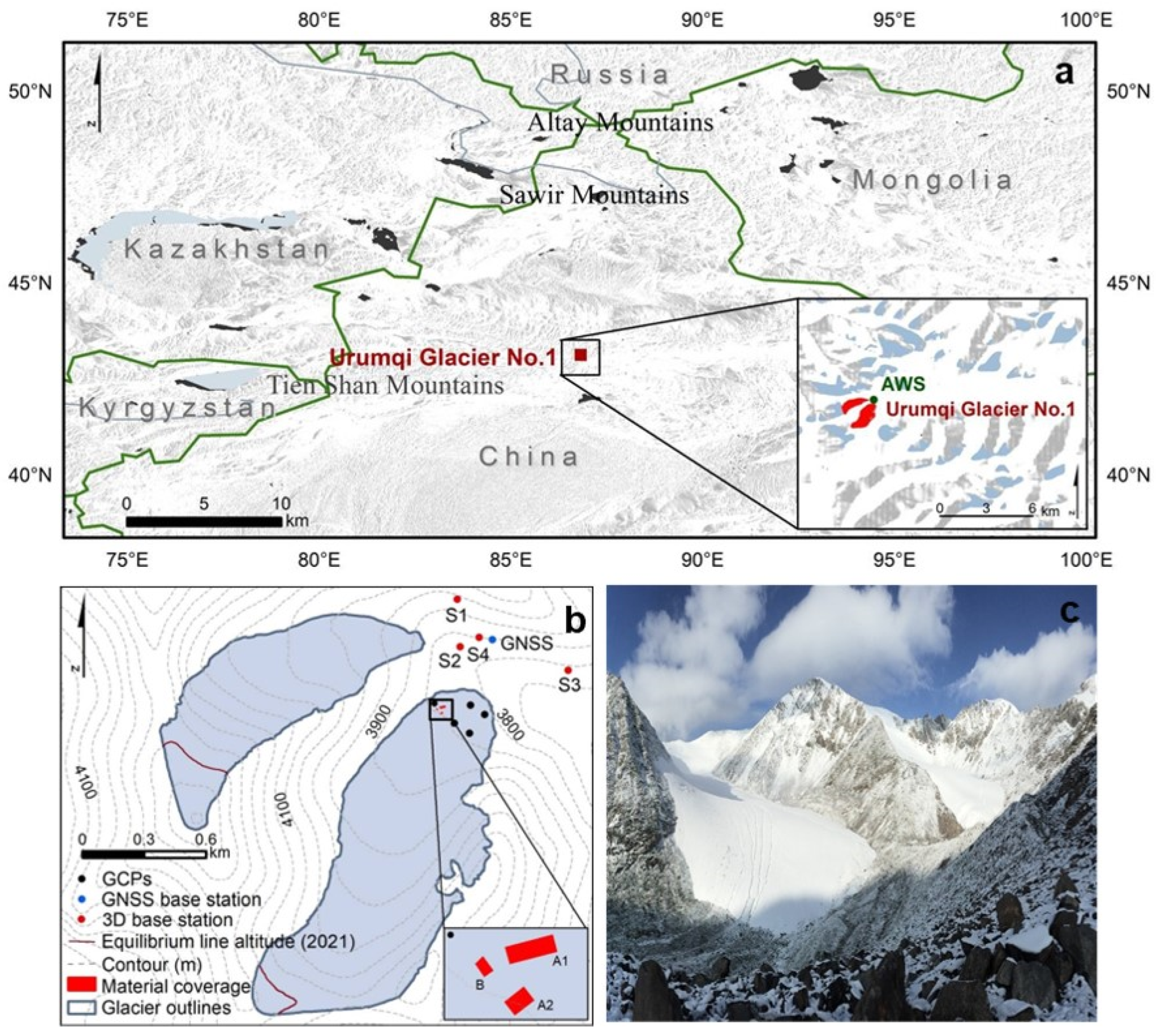
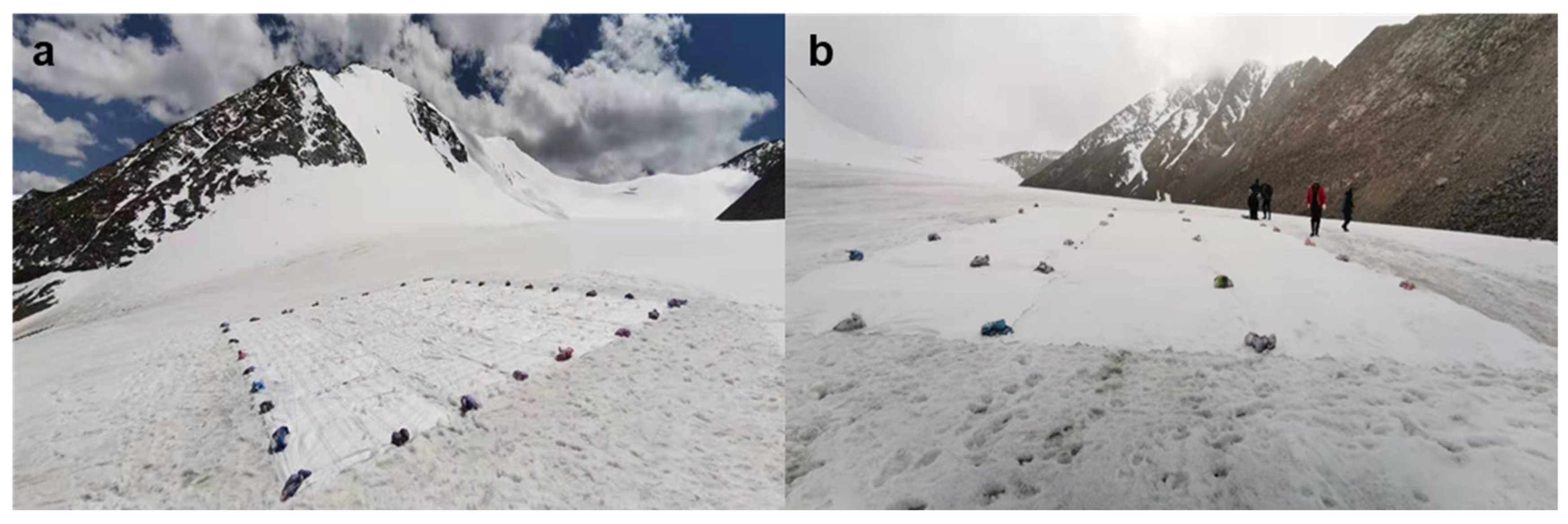
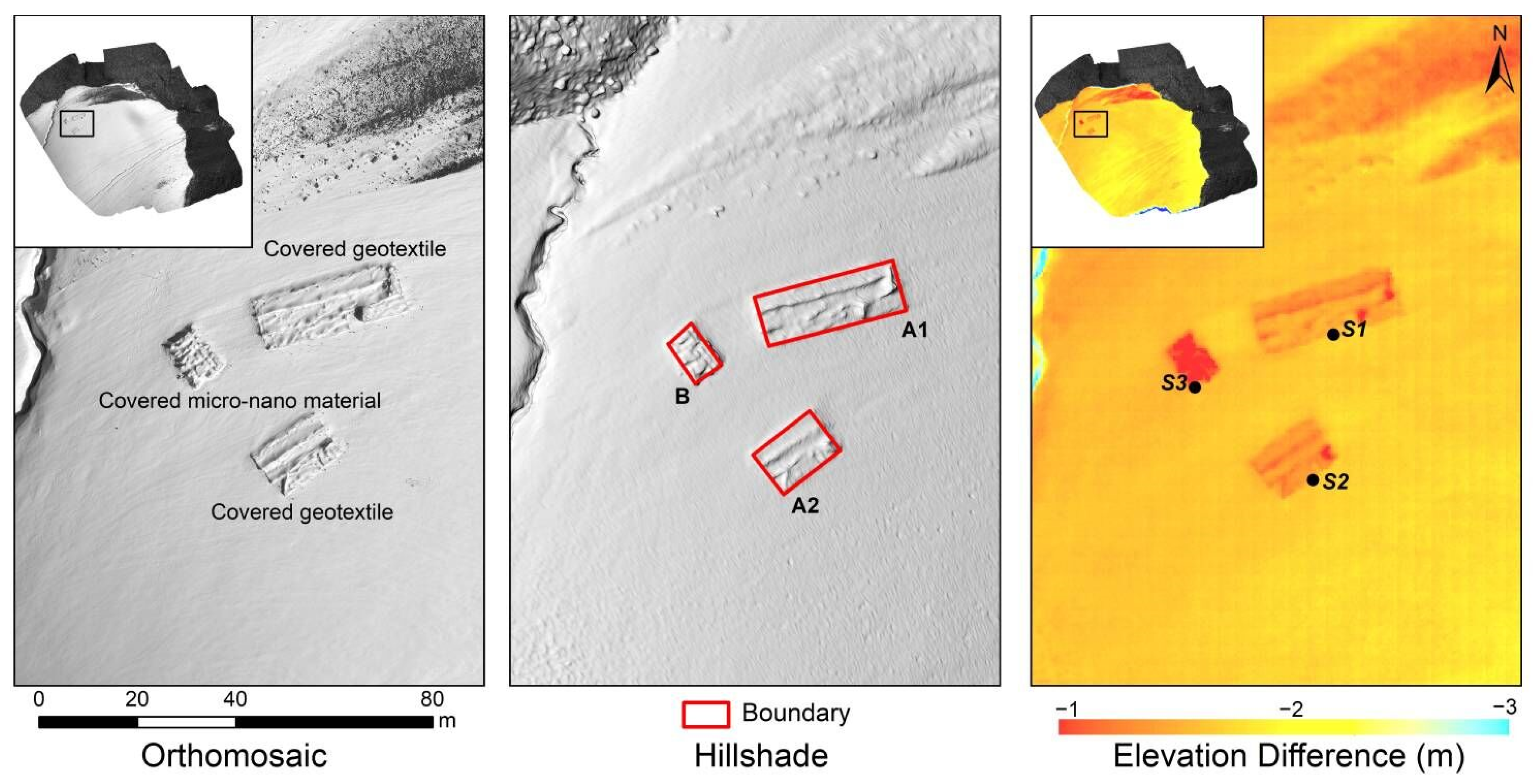

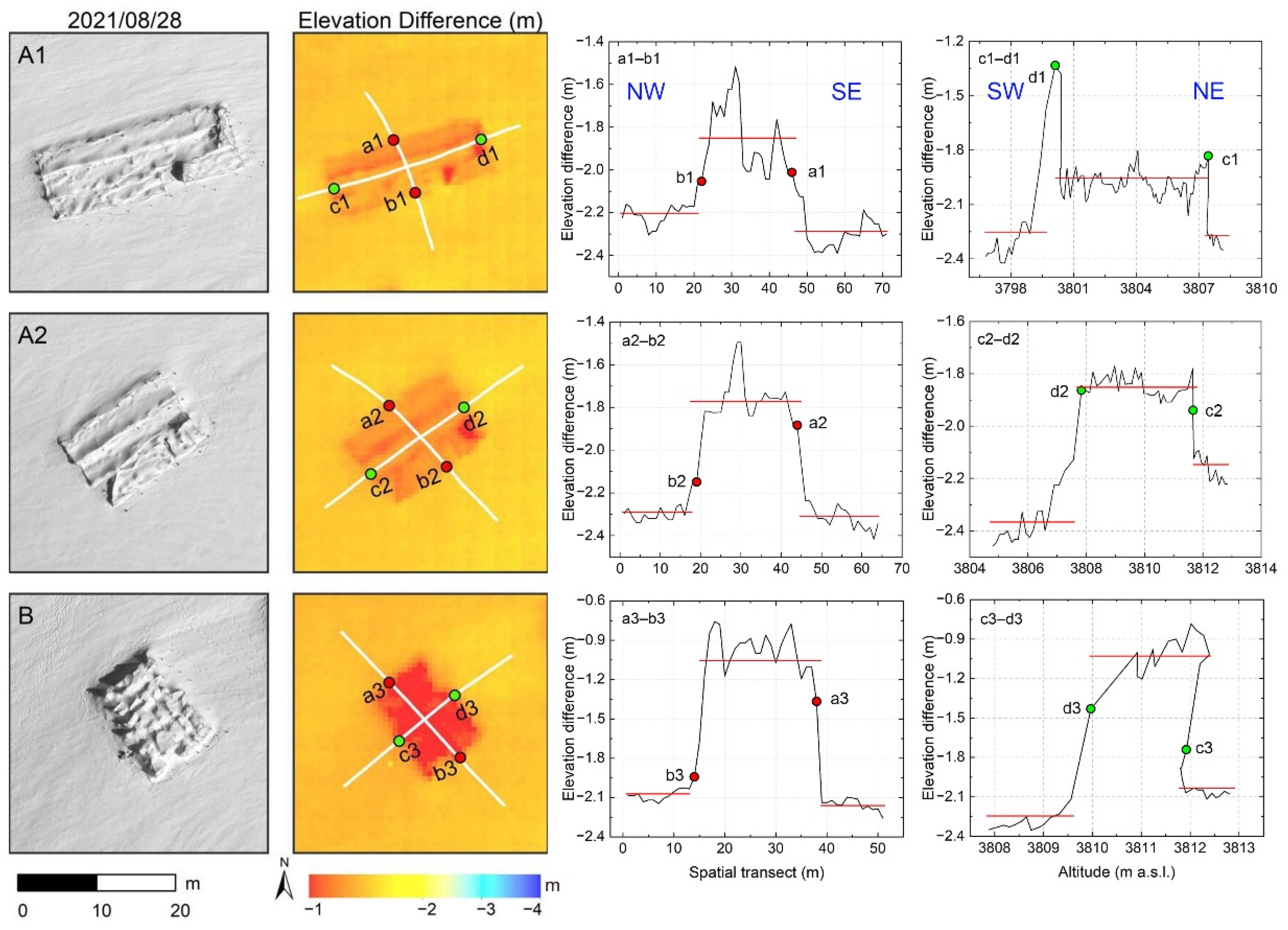

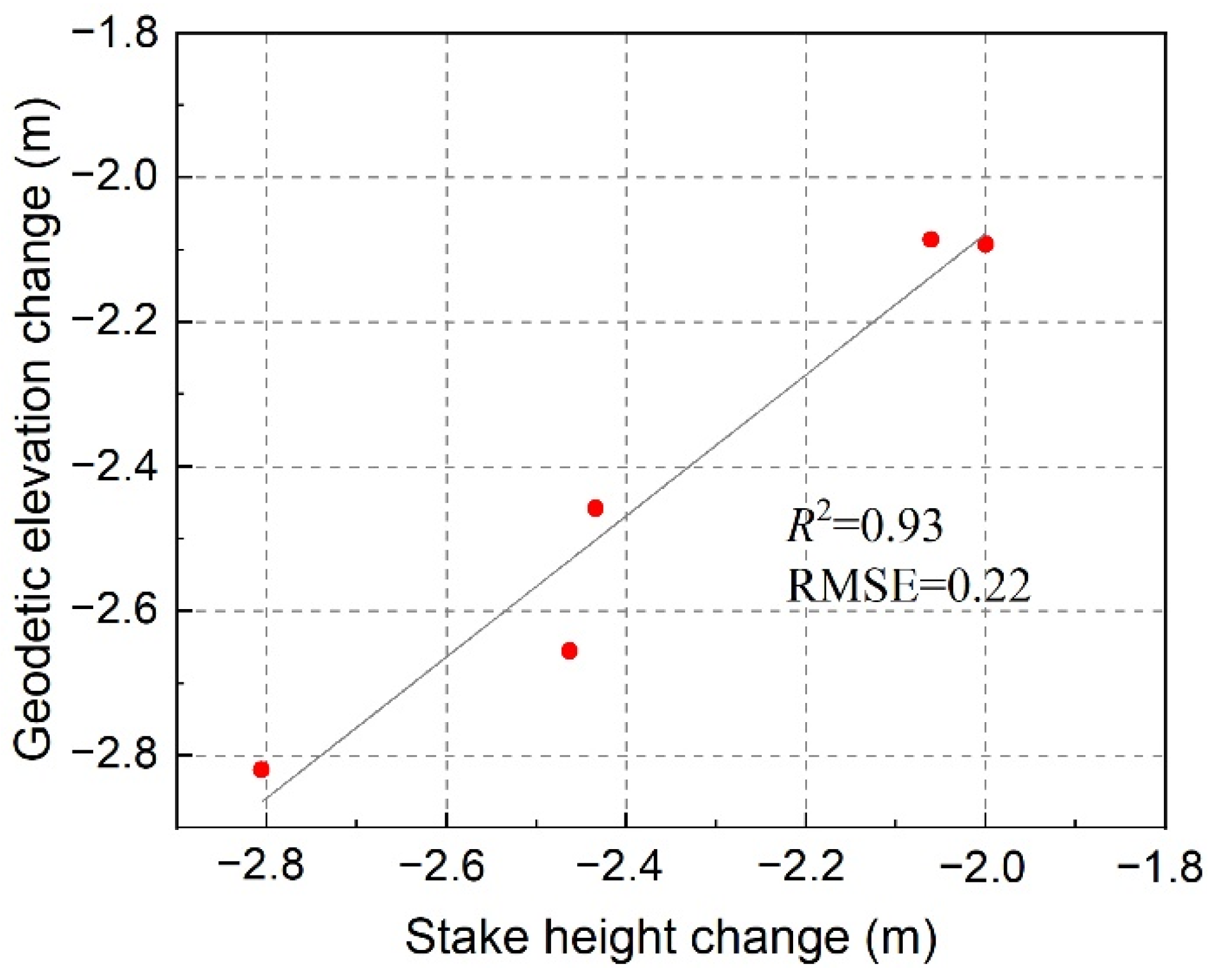


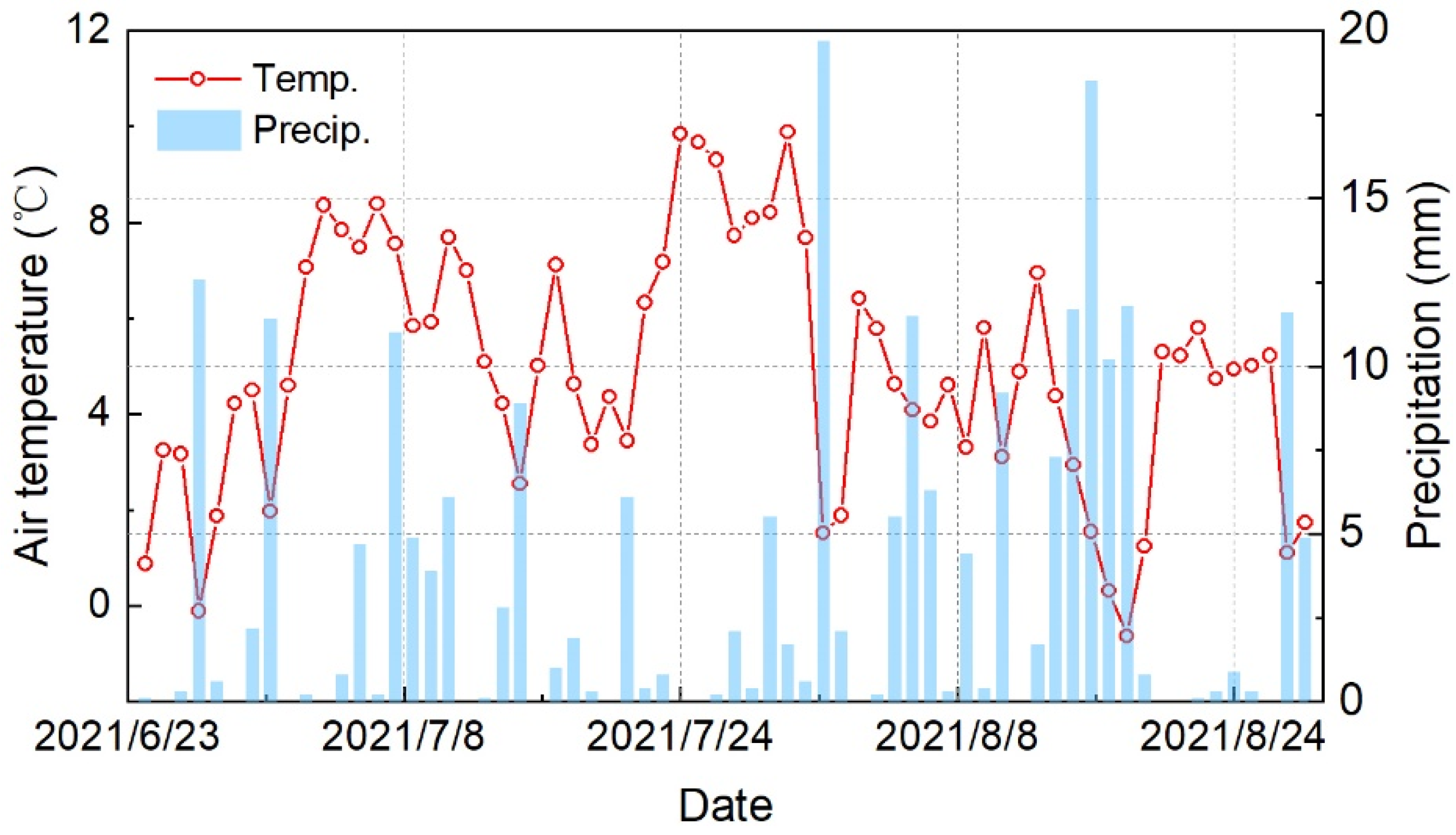
| Profile Name | Mean Elevation (m a.s.l.) | From 24 June to 28 August | ||||
|---|---|---|---|---|---|---|
| Ref | Exp | Abs. | ||||
| μ (m) | σ (m) | μ (m) | σ (m) | diff (m) | ||
| a1b1 | 3804 | −2.25 | 0.08 | −1.86 | 0.16 | 0.39 |
| a2b2 | 3809 | −2.30 | 0.06 | −1.78 | 0.13 | 0.52 |
| a3b3 | 3811 | −2.12 | 0.05 | −1.05 | 0.27 | 1.16 |
| c1d1 | 3803 | −2.26 | 0.17 | −1.95 | 0.14 | 0.31 |
| c2d2 | 3809 | −2.27 | 0.13 | −1.85 | 0.04 | 0.42 |
| c3d3 | 3811 | −2.17 | 0.15 | −1.06 | 0.23 | 1.11 |
| Glacier (Country) | Tested Period | Latitude (N) | Longitude (E) | Altitude (m a.s.l.) | Area (m2) | Material’s Chemical Composition | ϵ0 (%) | Source |
|---|---|---|---|---|---|---|---|---|
| Dosdè Est (Italy) | 15 May 2008–4 October 2008 | 46°23′ | 10°13′ | 2800 | 150 | Polyester, polypropylene | 69 | [10] |
| Presena Ovest (Italy) | 28 June 2010–14 September 2010 | 46°13′ | 10°34′ | 2765 | 600 | Polypropylene | 49 | [10] |
| Schaufelferner (Austria) | 22 June 2005–16 September 2005 | 46°59′ | 11°07′ | 2870 | 180 | Polyester, polypropylene | 60 | [9] |
| Mount Aragatz (Armenia) | 29 June 2012–22 June 2013 | 40°28′ | 44°10′ | 3200 | 20,000 | Double-bedded polypropylene/polyester | 57 | [4] |
| UG1 (China) | 24 June 2021–28 August 2021 | 43°07′ | 86°49′ | 3800 | 350 | Polypropylene | 29 | This study |
| UG1 (China) | 24 June 2021–28 August 2021 | 43°07′ | 86°49′ | 3800 | 100 | Cellulose acetate molecules | 56 | This study |
Publisher’s Note: MDPI stays neutral with regard to jurisdictional claims in published maps and institutional affiliations. |
© 2022 by the authors. Licensee MDPI, Basel, Switzerland. This article is an open access article distributed under the terms and conditions of the Creative Commons Attribution (CC BY) license (https://creativecommons.org/licenses/by/4.0/).
Share and Cite
Liu, S.; Wang, F.; Xie, Y.; Xu, C.; Xue, Y.; Yue, X.; Wang, L. Quantifying the Artificial Reduction of Glacial Ice Melt in a Mountain Glacier (Urumqi Glacier No. 1, Tien Shan, China). Remote Sens. 2022, 14, 2802. https://doi.org/10.3390/rs14122802
Liu S, Wang F, Xie Y, Xu C, Xue Y, Yue X, Wang L. Quantifying the Artificial Reduction of Glacial Ice Melt in a Mountain Glacier (Urumqi Glacier No. 1, Tien Shan, China). Remote Sensing. 2022; 14(12):2802. https://doi.org/10.3390/rs14122802
Chicago/Turabian StyleLiu, Shuangshuang, Feiteng Wang, Yida Xie, Chunhai Xu, Yuang Xue, Xiaoying Yue, and Lin Wang. 2022. "Quantifying the Artificial Reduction of Glacial Ice Melt in a Mountain Glacier (Urumqi Glacier No. 1, Tien Shan, China)" Remote Sensing 14, no. 12: 2802. https://doi.org/10.3390/rs14122802
APA StyleLiu, S., Wang, F., Xie, Y., Xu, C., Xue, Y., Yue, X., & Wang, L. (2022). Quantifying the Artificial Reduction of Glacial Ice Melt in a Mountain Glacier (Urumqi Glacier No. 1, Tien Shan, China). Remote Sensing, 14(12), 2802. https://doi.org/10.3390/rs14122802





